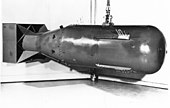
Back سلاح انشطاري معزز Arabic Усилено ядрено устройство Bulgarian Arma de fisión intensificada Spanish Kiihdytetty fissiopommi Finnish Bombe à fission dopée French Senjata fisi berpenggalak ID Arma nucleare a fissione amplificata Italian ブースト型核分裂兵器 Japanese 증폭형 핵분열탄 Korean Arma de fissão intensificada Portuguese
This article needs additional citations for verification. (August 2018) |

A boosted fission weapon usually refers to a type of nuclear bomb that uses a small amount of fusion fuel to increase the rate, and thus yield, of a fission reaction. The neutrons released by the fusion reactions add to the neutrons released due to fission, allowing for more neutron-induced fission reactions to take place. The rate of fission is thereby greatly increased such that much more of the fissile material is able to undergo fission before the core explosively disassembles. The fusion process itself adds only a small amount of energy to the process, perhaps 1%.[1]
The alternative meaning is an obsolete type of single-stage nuclear bomb that uses thermonuclear fusion on a large scale to create fast neutrons that can cause fission in depleted uranium, but which is not a two-stage hydrogen bomb. This type of bomb was referred to by Edward Teller as "Alarm Clock", and by Andrei Sakharov as "Sloika" or "Layer Cake" (Teller and Sakharov developed the idea independently, as far as is known).[2]
| Nuclear weapons |
|---|
 |
| Background |
| Nuclear-armed states |
|
- ^ "Facts about Nuclear Weapons: Boosted Fission Weapons", Indian Scientists Against Nuclear Weapons Archived July 8, 2008, at the Wayback Machine
- ^ Rhodes, Richard (1 August 1995). Dark Sun: The Making of the Hydrogen Bomb. Simon & Schuster. ISBN 978-0-68-480400-2. LCCN 95011070. OCLC 456652278. OL 7720934M. Wikidata Q105755363 – via Internet Archive.